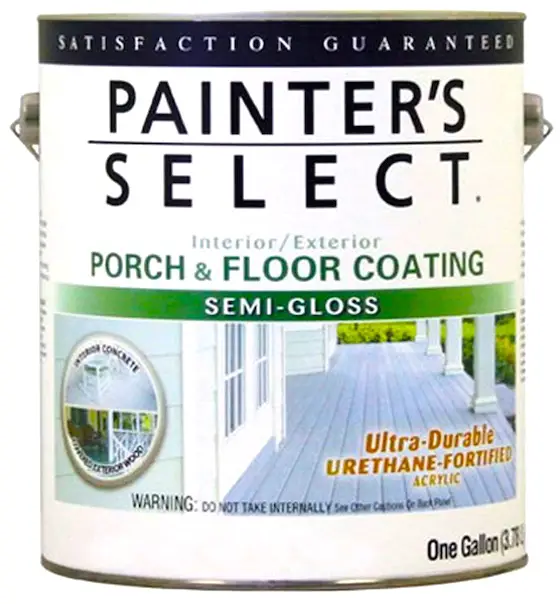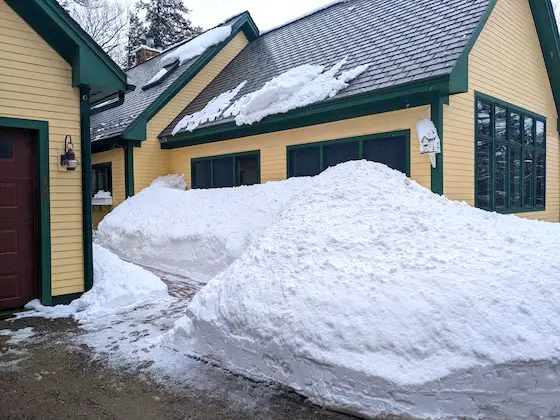Urethane House Paint

Urethane Paint | Read Tim's October 20, 2019 Newsletter to find out where this house is located. If you want to know how one picks a vibrant color as you see in the yellow and red, you should read my Selecting Exterior Paint Colors column.
Urethane Paint - It's Sticky and It's Fantastic
DEAR TIM: The exterior of my home needs to be painted this year. I would really like to buy a fantastic paint that will last a long time. In your opinion, what is the best exterior water-based paint? What are ideal painting conditions? Bradley G., Worthington, OH
DEAR BRADLEY: It sounds like you and I are in the same boat. I am painting my own home this summer. Fortunately for me, the preliminary work required to prepare my house for paint is minimal. My existing wood siding is in great shape and the previous coating is not peeling. Prep work is actually the most important part of any paint job. Whatever you do, do not take shortcuts as you prepare the surfaces for paint. Extra minutes spent in prep work can add years to the life span of a paint job. Always follow the instructions listed on paint can labels.
Is Paint Just Colored Glue?
Paints are simply glues that contain color. Poor-quality paints contain low-quality ingredients. These inexpensive paints are the ones that typically fail first. Until recently there were just two groups of exterior water-based paint. One type contains vinyl acetate as the glue or resin in the paint. The other group consists of those paints that contain 100 percent acrylic resin. Guess what? There is a new kid on the block. It is an exterior paint that contains both acrylic and water-based polyurethane resins.

This is a urethane house paint. Look at the label. CLICK or TAP HERE to order it now.
Does Urethane Resin Stick Well to Siding and Trim?
The polyurethane resin or glue in this new exterior paint tenaciously holds onto whatever it contacts. I recently started to paint my own home with this new paint. As usually happens, I tend to get paint splatters on my hands, arms, and legs. In the old days, I could clean off these splatters quite easily at the end of the day with regular soap and water. The first day I used the polyurethane paint, I could not get the paint off my hands! I was in a state of shock, not at the appearance of my hands, but at how incredibly sticky the paint was!
Is the exterior of your house looking drab? Find the professional painters by using my Exterior Painting & Staining Checklist. I offer a 100% Money Back Guarantee.
Why Was Urethane Paint Developed?
The makers of this new paint actually developed it to save homeowners money. The instructions on the label of this new paint clearly state that you do not need to wash down dirty, glossy, or chalky surfaces before you paint. Evidently the polyurethane resin drives through the dirt and chalk and grabs hold of the previously painted surface. The manufacturers feel so strongly about this claim that they supply a lifetime warranty with the paint.
Should I Wash My House With Soap and Water Before Painting?
Yes, you must wash your house with soap and water before painting.
It goes against everything I have been taught and experienced to NOT clean a surface prior to painting. I feel it is always a great idea to do this extra step. If you wash the outside of your home with oxygen bleach and soap and water before you use the polyurethane paint, I can assure you that it will stick like you can't believe. I am washing my house by hand to get the best results. I avoid pressure washing because the process can damage the wood and drive water deep into cracks, holes, and the wood itself.
How Do You Use Oxygen Bleach?
I prefer to mix up oxygen bleach with hot water. Once I add the powder, I stir until it's dissolved and then put it in a hand-pump sprayer.
I then squirt the solution on the dirty surfaces so they are very wet. Keep the surfaces wet with the solution for about 5 or 10 minutes. Then apply the soapy water solution with a softer brush commonly used to clean RVs or the sides of large trucks. This brush is made to clean flat surfaces. Immediately rinse the surfaces with clean water after scrubbing.
How Much Surface Area Do You Clean?
I prefer to clean only 100 square feet of area if working alone. If I have a helper, that person squirts on the oxygen bleach solution and is the rinse person. This allows the scrubber to work constantly making great progress.
What is the Best Air Temperature to Paint?
If at all possible try to paint when the air temperature is between 50 and 85 F. You can actually exceed these limits in some instances and not void the warranty on most paints. Never paint in direct sunlight. Always paint surfaces after the sun has hit them. If you paint a surface and then the sun hits it, the paint can actually develop blisters in a matter of minutes!
Should I Paint in Stormy Weather?
Avoid painting when there is a threat of storms. A driving rain can quickly wash off a water-based paint from a surface causing all sorts of damage to roof areas, driveways, and sidewalks. Overcast days with relative humidity in the 50 percent range are ideal painting days. These weather conditions allow the paint to dry somewhat slowly. The slower dry time gives the paint adequate time to develop a strong chemical and mechanical bond to the surface being painted.
What Urethane Paint Did You Use?
The paint I used in the summer of 2010 to paint my New Hampshire house was Duration available at Sherwin Williams stores. Be SURE to ask for the manager and have her/him show you on the label the paint is made with urethane resin. Since that time, the Duration brand has transitioned to a lower-quality acrylic-resin paint. You now must ask for the Emerald brand as of 2023 OR click the paint can above and buy urethane paint on Amazon.com.
Here's how good the urethane paint looks after thirteen years of harsh winter weather! There's not one place where it's peeled.

This photo was taken the first week of March of 2023. This is how deep the snow can get at the end of my sidewalk where the snow blower piles it up high. A month later the sun had melted all of this frozen water. I could have built a fantastic snow cave inside this mound! Copyright 2023 Tim Carter
24 Responses to Urethane House Paint